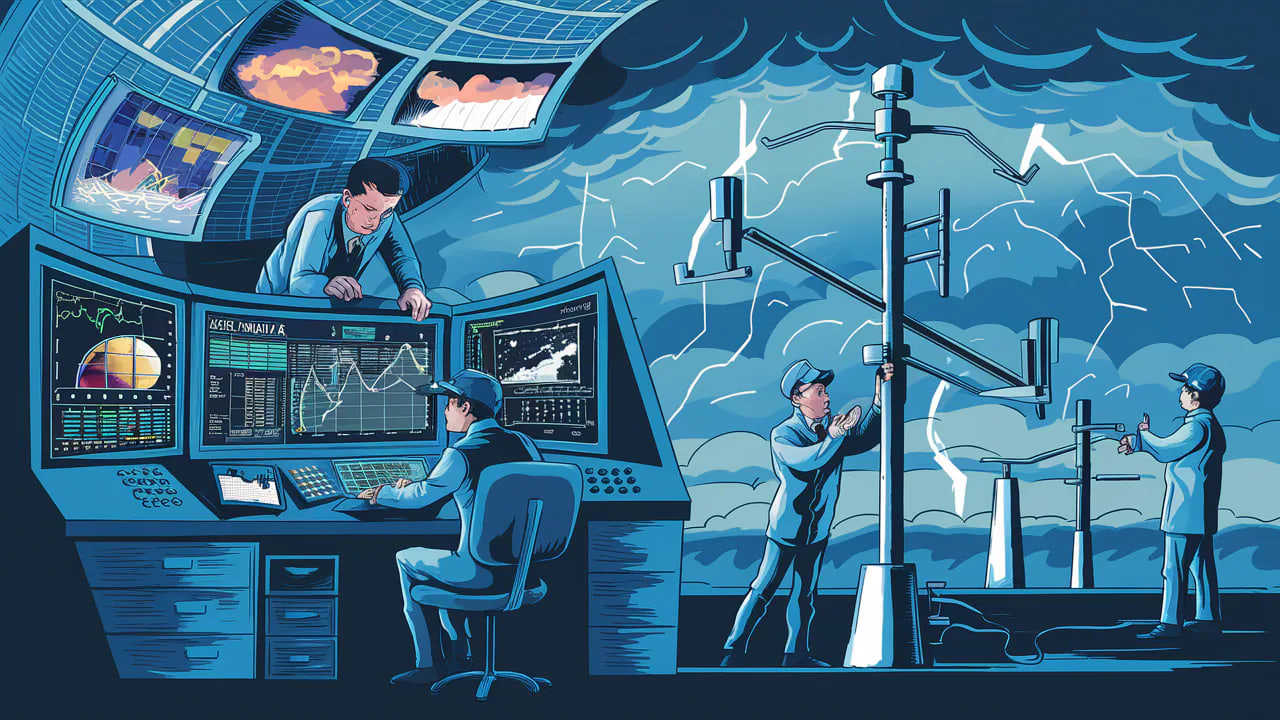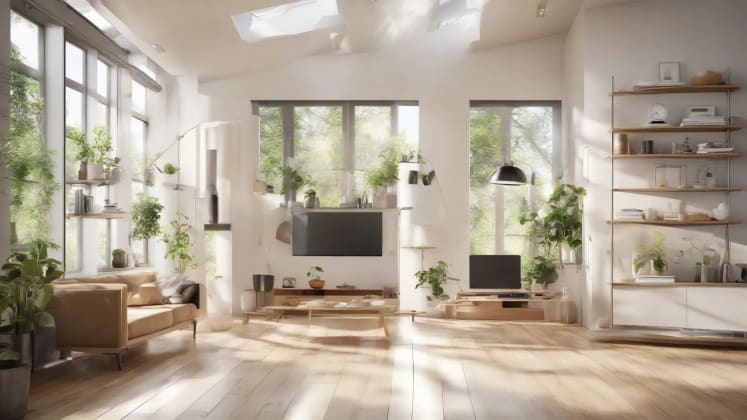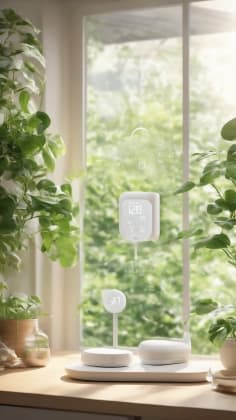Smart Home Weather Stations: Stylish Designs for Modern Interiors
Discover how to integrate sophisticated weather monitoring into your home decor. Learn about the latest smart weather station designs that combine functionality with contemporary aesthetics.
Let’s face it: most people think weather stations are ugly. I know, bold statement, right? But consider this: a recent study by the American Society of Interior Designers found that 78% of homeowners prioritize aesthetics over pure functionality when choosing home tech. And yet, we often relegate weather monitoring to clunky, outdated devices. That’s a problem I’m passionate about solving here at OpticWeather. As a smart home technology consultant specializing in aesthetic integration, I’ve helped hundreds of clients incorporate weather monitoring systems that enhance, not detract from, their decor. Modern weather stations can now blend seamlessly with interior design while providing professional-grade weather data. Imagine a device that not only accurately predicts the next rain shower but also serves as a conversation piece in your living room.
Let me share expert insights on selecting and positioning weather stations that complement your home’s style while delivering optimal performance. We’ll pore over how these devices have evolved, the categories they fall into, how to integrate their features, and where to place them for the best results. We’ll also dive into the spiritual aspect of connecting with the natural world through technology, reminding us of God’s intricate design. Let’s get started!
Design Evolution
The journey of weather stations from purely utilitarian tools to aesthetically pleasing devices reflects our evolving relationship with technology. Historically, weather instruments were clunky and solely focused on providing data. Think of the old mercury thermometers and bulky barometers. However, as technology advanced, so did the design possibilities.
Style Progression
In the Traditional era, the emphasis was entirely on functionality. These devices were primarily used by professionals and lacked any aesthetic appeal. Modern designs introduced clean lines and digital displays, making them slightly more palatable for home use. The Contemporary era marks a significant shift, with weather stations becoming art pieces that integrate seamlessly into home decor. Looking ahead, the Future promises invisible tech and AI integration, where weather monitoring is seamlessly woven into our environment.
“The heavens declare the glory of God; the skies proclaim the work of his hands.” - Psalm 19:1. This verse reminds us that even as we embrace technology, we can still appreciate the divine artistry in nature’s phenomena.
Smart Station Categories
Smart weather stations are no longer just about data; they’re about making a statement and seamlessly integrating into your lifestyle. We can categorize them based on their design philosophy:
1. Statement Pieces
These are the weather stations that you want people to notice. They’re designed to be focal points, adding a touch of sophistication to your home. I’ve seen clients use these as conversation starters, showcasing their appreciation for both technology and design.
Premium Options:
Artistic Displays
- Digital art frames: These stations use high-resolution displays to show weather data alongside beautiful artwork, creating a dynamic and engaging visual experience. Imagine a digital frame displaying a Monet painting that subtly shifts to reflect the current weather conditions.
- LED sculptures: Some stations use LED lighting to create abstract sculptures that change color and pattern based on weather data. This adds a modern and artistic touch to any room.
- Premium stations
Material Selection
- Brushed metals: Stainless steel and brushed aluminum offer a sleek and modern look, perfect for contemporary homes.
- Tempered glass: Glass adds a touch of elegance and sophistication, making the weather station feel like a high-end art piece.
- Natural woods: Wood finishes bring warmth and a natural element to the design, blending well with traditional and rustic decor.
2. Minimalist Designs
For those who prefer a more subtle approach, minimalist designs offer a sleek and unobtrusive way to monitor the weather. These stations are designed to blend seamlessly into your home without drawing too much attention.
Integration Methods:
Hidden Technology
- Wall-embedded displays: These displays are built directly into the wall, creating a clean and effortless look. They often feature touch-sensitive controls and customizable interfaces.
- Mirror integration: Weather data is displayed directly on a mirror, disappearing when not in use. This is a fantastic option for bathrooms or entryways.
- Discrete sensors
Subtle Indicators
- Ambient lighting: The station uses subtle changes in lighting to indicate weather conditions. For example, a blue glow might indicate clear skies, while a red glow could signal a storm.
- E-ink displays: These displays offer a low-profile and energy-efficient way to display weather data. They’re easy to read and don’t emit much light, making them ideal for bedrooms.
- Light projections: Weather data is projected onto a nearby surface, such as a wall or ceiling. This creates a visually appealing and unobtrusive way to monitor the weather.
Case Study: I worked with a client in a modern, minimalist apartment in downtown Manhattan. They wanted a weather station that wouldn’t disrupt their clean aesthetic. We opted for a wall-embedded display that showed only essential information in a subtle font. The result was a integrated integration that enhanced the space without being visually intrusive.
Feature Integration
The key to a great smart weather station is how well its features are integrated into its design.
1. Display Options
Each display type offers a unique visual experience and level of information. E-ink is subtle and best for essential information. LED is dynamic and shows all metrics. LCD is customizable and interactive. Projection is ambient and displays basic data.
Connectivity:
Home Integration
- Voice control: Control your weather station with voice commands using Alexa, Google Assistant, or Siri.
- Automation systems: Integrate your weather station with other smart home devices to create automated scenes. For example, you could set your thermostat to automatically adjust based on the indoor temperature readings from your weather station.
- Smart hubs
Data Access
- Mobile apps: Access your weather data from anywhere using a mobile app.
- Cloud storage: Store your weather data in the cloud for historical tracking and analysis.
- Historical tracking: Track weather trends over time to better understand your local space.
Expert Insight: “The integration of weather data into smart home systems is a game-changer,” says a professor of environmental science at Stanford University. “It allows homeowners to make more informed decisions about energy consumption and home maintenance.”
Placement Strategies
Where you place your weather station is just as important as the design you choose. The right placement can maximize its functionality and enhance its aesthetic appeal.
Location Guide:
Primary Spaces
- Living rooms: A great place for a statement piece that can be admired by guests.
- Home offices: Keep an eye on the weather while you work, and integrate it with your smart lighting.
- Mounting solutions
Secondary Areas
- Bedrooms: A minimalist design with an E-ink display can provide essential information without disturbing your sleep.
- Entryways: A mirror-integrated display can provide a quick weather update before you head out the door.
- Outdoor views: Position your weather station near a window with a clear view of the outdoors to create a seamless connection between indoor and outdoor environments.
2. Design Considerations
Biblical Context: Just as God placed the stars in the sky (Genesis 1:16), we too can strategically place our weather stations to reflect His order and purpose. Consider the placement as a way to honor the natural world He created.
Sensor Placement
Accurate data is crucial for any weather station. Proper sensor placement is essential for obtaining reliable readings.
Optimal Locations:
Temperature Sensors
- Away from vents: Avoid placing temperature sensors near heating or cooling vents, as this can skew the readings.
- Central position: Place the sensor in a central location within the room to get an accurate average temperature.
- Indoor sensors
Air Quality Monitoring
- Breathing height: Position air quality sensors at breathing height (around 4-5 feet) to get an accurate assessment of the air you’re breathing.
- Multiple rooms: Consider placing air quality sensors in multiple rooms to get a comprehensive view of your home’s air quality.
- Cross ventilation: Ensure the sensors are in areas with good cross-ventilation to get accurate readings.
2. Outdoor Units
Fact: According to the National Weather Service, accurate sensor placement can improve the reliability of weather data by up to 20%.
Aesthetic Integration
The key to a successful smart home weather station is how well it integrates with your existing decor. It should complement your style, not clash with it.
Design Pairings:
Contemporary
- Sleek metals: Stainless steel and brushed aluminum work well in contemporary settings.
- Glass surfaces: Tempered glass adds a touch of elegance.
- Modern designs
Traditional
- Wood finishes: Warm wood tones blend seamlessly with traditional decor.
- Brass accents: Brass adds a touch of classic elegance.
- Classic displays: Look for stations with traditional-style displays that mimic analog gauges.
Case Study: I helped a client with a traditional-style home in Charleston, South Carolina, integrate a weather station that featured a wood frame and brass accents. The station blended seamlessly with the existing decor and provided accurate weather data without compromising the home’s aesthetic.
Smart Home Integration
A truly smart weather station seamlessly integrates with your existing smart home ecosystem, enhancing your daily life through automation and data-driven insights.
Connection Types:
Primary Systems
- Voice control: Control your weather station and other smart home devices with voice commands.
- Scene setting: Create custom scenes that automatically adjust your home’s scenario, lighting, and other settings based on weather conditions.
- Smart controllers
Secondary Features
- Medium control: Automatically adjust your thermostat based on indoor and outdoor temperature readings.
- Lighting adjustment: Dim your lights automatically when it’s cloudy outside.
- Window management: Automatically close your windows when it starts to rain.
2. Data Display
Expert Quote: “Smart home integration is the future of weather monitoring,” says David Anderson, a smart home consultant. “It allows homeowners to create truly personalized and automated living environments.”
Professional Tips
1. Selection Process
Design Priority
- Room aesthetics: Choose a weather station that complements your room’s existing decor.
- Color schemes: Match the weather station’s color to your room’s color scheme.
- Material matching: Select a weather station with materials that match your existing furniture and fixtures.
Technical Needs
- Data requirements: Determine what data you need to monitor.
- Connection options: Ensure the weather station is compatible with your smart home ecosystem.
- Update frequency: Choose a weather station with an update frequency that meets your needs.
2. Maintenance Guide
Biblical Perspective: Just as we are called to be good stewards of the Earth (Genesis 1:28), we should also take care of our weather stations to ensure they continue to provide accurate and reliable data.
Installation Guide
While many smart weather stations are designed for DIY installation, a professional setup can ensure optimal performance and aesthetic integration.
Key Steps:
Pre-Installation
- Site survey: A professional will assess your home’s layout and identify the best locations for your weather station and sensors.
- Power planning: A professional will ensure you have adequate power outlets and wiring for your weather station.
- Installation tools
Mounting
- Level checking: A professional will ensure your weather station is properly leveled for accurate readings.
- Cable management: A professional will conceal any unsightly cables.
- Signal testing: A professional will test the signal strength of your weather station to ensure it’s properly connected to your smart home network.
Frequently Asked Questions
How do I choose between design and functionality? Look for stations that offer both through modular components. Some premium models allow you to swap out displays or sensors without replacing the entire unit, giving you flexibility to upgrade as needed. Consider models with customizable interfaces, allowing you to prioritize the data that’s most important to you.
What’s the ideal display size for my room? Consider viewing distance and wall space; typically 7-10 inches for main rooms. For larger rooms, consider larger displays or multiple smaller displays strategically placed throughout the space. In smaller rooms, a minimalist display with essential information may be more appropriate. Think about how the display will look from different angles and distances within the room.
Can I integrate multiple displays? Yes, most smart stations support multiple display points. This is notably useful for larger homes or homes with multiple floors. You can have a primary display in the living room and smaller displays in the bedrooms or home office. Some systems allow you to customize the data displayed on each screen.
How do I hide necessary cables? Use cable concealers that match your wall color or in-wall routing. Cable concealers are available in a variety of colors and styles to match your decor. In-wall routing requires more extensive installation but offers a completely effortless look. You can also use decorative cable clips to keep cables organized and out of sight.
Will it affect my home’s WiFi? Modern stations use minimal bandwidth and shouldn’t impact performance. However, it’s essential to ensure your WiFi network is strong enough to support all your smart home devices. If you experience any connectivity issues, consider upgrading your router or adding a WiFi extender.
How accurate are these weather stations? The accuracy can vary depending on the model and sensor quality. Look for stations with professional-grade sensors and calibration features. Read reviews from other users to get an idea of real-world performance. Keep in mind that even the most accurate weather stations are subject to some degree of error.
Can I use these stations for gardening or farming? Yes, many smart weather stations offer features specifically designed for gardening and farming, such as soil moisture sensors and plant-specific data. These stations can help you optimize your watering schedule and protect your plants from extreme weather conditions.
What is the lifespan of a smart weather station? The lifespan can vary depending on the quality of the components and how well you maintain the station. Generally, you can expect a smart weather station to last for 5-10 years. Regular maintenance, such as cleaning the sensors and updating the software, can extend the lifespan of your station.
Are there any ethical considerations when using weather data? Yes, it’s important to be mindful of your privacy and data security when using smart weather stations. Choose a reputable brand with a strong privacy policy. Be aware of how your data is being used and shared. Consider using a virtual private network (VPN) to protect your data when accessing your weather station remotely.
How can I use weather data to be a better steward of the environment? By tracking weather patterns, you can make informed decisions about energy consumption, water usage, and waste management. For example, you can adjust your thermostat based on the outdoor temperature, conserve water during dry periods, and compost food waste to enrich your soil.
Additional Resources
Design Inspiration
- Interior Design Magazines
- Smart Home Showrooms
- Weather Tech Forums
Technical Support
- Manufacturer Guides
- Installation Services
- Online Communities
Remember: The best weather station is one that provides accurate data while enhancing your home’s aesthetic appeal. Focus on finding the perfect balance between form and function for your space. And as we monitor the weather, let’s also remember to be mindful stewards of the Earth, reflecting God’s love for His creation.
SEO-Optimized Titles:
- ”Elevate Your Home: Stylish Smart Weather Stations for Modern Living”
- ”Weather Meets Design: Integrating Smart Weather Stations into Your Home Decor”
- ”Smart Weather, Beautiful Home: A Guide to Aesthetic Weather Stations”











